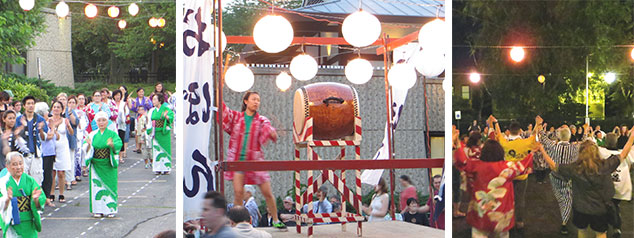Bon Odori Festival

On a warm summer evening we carry on an ancient Buddhist tradition of honoring past loved ones through the Bon Odori Festival. With colorful lanterns lighting the area, we dance to traditional Japanese music and live taiko drumming to show appreciation for those who have passed before us.
A Brief History of Bon Odori
The Obon, one of the most widely celebrated and colorful of the Buddhist observances, dates back 1500 years.
The origin of the Obon is generally linked to the Ullambana-sutra which tells the story of Mogallana, one of the great disciples of the Buddha. In this story, Mogallana sees his departed mother suffering in the fiery domain of the Hungry Devils, a domain where hunger and thirst know no bounds.
Everything that is touched immediately bursts into flames. Grieving at what he sees, he attempts to relieve her suffering but his attempts are futile. In desperation, he goes to the Buddha and the All Compassionate One shows him the way.
Following the path shown him, he finally succeeds. He and his friends rejoice, expressing their joy and gratitude with music and dancing.
The Bon Odori held at night between mid-July through mid-August is symbolic of that occasion. It is a time of rejoicing and expressing gratitude in the same manner as did Mogallana and his friends. This is the tradition of the Obon.
The Obon is essentially a memorial observance, in which homage and respect are paid to the dead. In doing so, thought is directed toward their deeds, virtues, endeavors and life; all of which affected the heritage that is now ours. With thoughts thus aligned, attention is focused upon the Oneness of the past, present and future—to the interdependency and harmony of all existence.
The next morning, following the evening of colorful lights and festive dance, Obon service is held at the temple.

